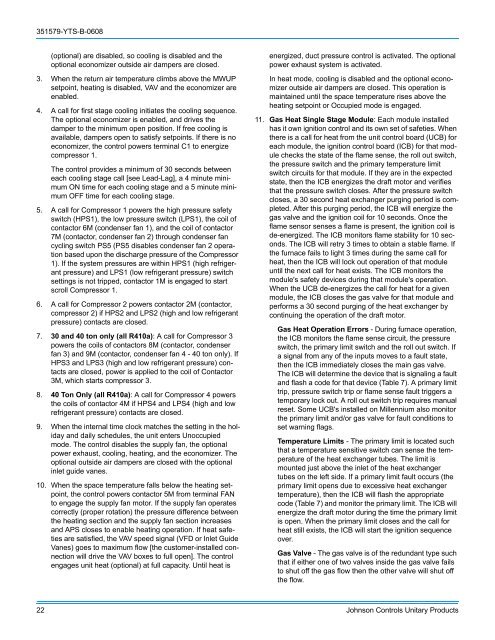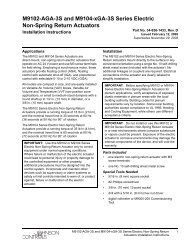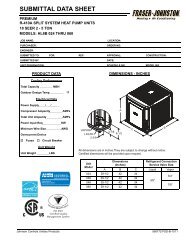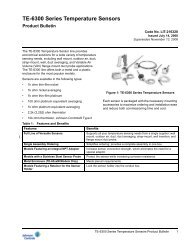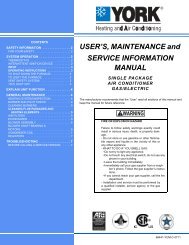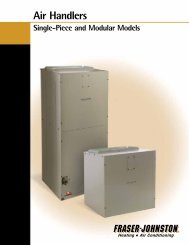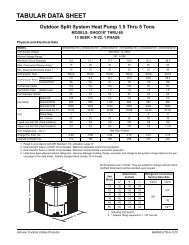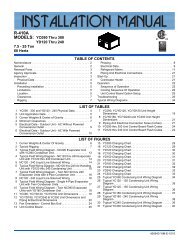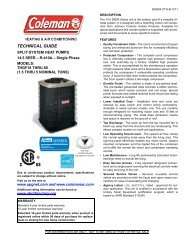analog to digital converter . . . . . . . . . . . . . . . 4 - UPGNet
analog to digital converter . . . . . . . . . . . . . . . 4 - UPGNet
analog to digital converter . . . . . . . . . . . . . . . 4 - UPGNet
You also want an ePaper? Increase the reach of your titles
YUMPU automatically turns print PDFs into web optimized ePapers that Google loves.
351579-YTS-B-0608(optional) are disabled, so cooling is disabled and theoptional economizer outside air dampers are closed.3. When the return air temperature climbs above the MWUPsetpoint, heating is disabled, VAV and the economizer areenabled.4. A call for first stage cooling initiates the cooling sequence.The optional economizer is enabled, and drives thedamper <strong>to</strong> the minimum open position. If free cooling isavailable, dampers open <strong>to</strong> satisfy setpoints. If there is noeconomizer, the control powers terminal C1 <strong>to</strong> energizecompressor 1.The control provides a minimum of 30 seconds betweeneach cooling stage call [see Lead-Lag], a 4 minute minimumON time for each cooling stage and a 5 minute minimumOFF time for each cooling stage.5. A call for Compressor 1 powers the high pressure safetyswitch (HPS1), the low pressure switch (LPS1), the coil ofcontac<strong>to</strong>r 6M (condenser fan 1), and the coil of contac<strong>to</strong>r7M (contac<strong>to</strong>r, condenser fan 2) through condenser fancycling switch PS5 (PS5 disables condenser fan 2 operationbased upon the discharge pressure of the Compressor1). If the system pressures are within HPS1 (high refrigerantpressure) and LPS1 (low refrigerant pressure) switchsettings is not tripped, contac<strong>to</strong>r 1M is engaged <strong>to</strong> startscroll Compressor 1.6. A call for Compressor 2 powers contac<strong>to</strong>r 2M (contac<strong>to</strong>r,compressor 2) if HPS2 and LPS2 (high and low refrigerantpressure) contacts are closed.7. 30 and 40 <strong>to</strong>n only (all R410a): A call for Compressor 3powers the coils of contac<strong>to</strong>rs 8M (contac<strong>to</strong>r, condenserfan 3) and 9M (contac<strong>to</strong>r, condenser fan 4 - 40 <strong>to</strong>n only). IfHPS3 and LPS3 (high and low refrigerant pressure) contactsare closed, power is applied <strong>to</strong> the coil of Contac<strong>to</strong>r3M, which starts compressor 3.8. 40 Ton Only (all R410a): A call for Compressor 4 powersthe coils of contac<strong>to</strong>r 4M if HPS4 and LPS4 (high and lowrefrigerant pressure) contacts are closed.9. When the internal time clock matches the setting in the holidayand daily schedules, the unit enters Unoccupiedmode. The control disables the supply fan, the optionalpower exhaust, cooling, heating, and the economizer. Theoptional outside air dampers are closed with the optionalinlet guide vanes.10. When the space temperature falls below the heating setpoint,the control powers contac<strong>to</strong>r 5M from terminal FAN<strong>to</strong> engage the supply fan mo<strong>to</strong>r. If the supply fan operatescorrectly (proper rotation) the pressure difference betweenthe heating section and the supply fan section increasesand APS closes <strong>to</strong> enable heating operation. If heat safetiesare satisfied, the VAV speed signal (VFD or Inlet GuideVanes) goes <strong>to</strong> maximum flow [the cus<strong>to</strong>mer-installed connectionwill drive the VAV boxes <strong>to</strong> full open]. The controlengages unit heat (optional) at full capacity. Until heat isenergized, duct pressure control is activated. The optionalpower exhaust system is activated.In heat mode, cooling is disabled and the optional economizeroutside air dampers are closed. This operation ismaintained until the space temperature rises above theheating setpoint or Occupied mode is engaged.11. Gas Heat Single Stage Module: Each module installedhas it own ignition control and its own set of safeties. Whenthere is a call for heat from the unit control board (UCB) foreach module, the ignition control board (ICB) for that modulechecks the state of the flame sense, the roll out switch,the pressure switch and the primary temperature limitswitch circuits for that module. If they are in the expectedstate, then the ICB energizes the draft mo<strong>to</strong>r and verifiesthat the pressure switch closes. After the pressure switchcloses, a 30 second heat exchanger purging period is completed.After this purging period, the ICB will energize thegas valve and the ignition coil for 10 seconds. Once theflame sensor senses a flame is present, the ignition coil isde-energized. The ICB moni<strong>to</strong>rs flame stability for 10 seconds.The ICB will retry 3 times <strong>to</strong> obtain a stable flame. Ifthe furnace fails <strong>to</strong> light 3 times during the same call forheat, then the ICB will lock out operation of that moduleuntil the next call for heat exists. The ICB moni<strong>to</strong>rs themodule's safety devices during that module's operation.When the UCB de-energizes the call for heat for a givenmodule, the ICB closes the gas valve for that module andperforms a 30 second purging of the heat exchanger bycontinuing the operation of the draft mo<strong>to</strong>r.Gas Heat Operation Errors - During furnace operation,the ICB moni<strong>to</strong>rs the flame sense circuit, the pressureswitch, the primary limit switch and the roll out switch. Ifa signal from any of the inputs moves <strong>to</strong> a fault state,then the ICB immediately closes the main gas valve.The ICB will determine the device that is signaling a faultand flash a code for that device (Table 7). A primary limittrip, pressure switch trip or flame sense fault triggers atemporary lock out. A roll out switch trip requires manualreset. Some UCB's installed on Millennium also moni<strong>to</strong>rthe primary limit and/or gas valve for fault conditions <strong>to</strong>set warning flags.Temperature Limits - The primary limit is located suchthat a temperature sensitive switch can sense the temperatureof the heat exchanger tubes. The limit ismounted just above the inlet of the heat exchangertubes on the left side. If a primary limit fault occurs (theprimary limit opens due <strong>to</strong> excessive heat exchangertemperature), then the ICB will flash the appropriatecode (Table 7) and moni<strong>to</strong>r the primary limit. The ICB willenergize the draft mo<strong>to</strong>r during the time the primary limitis open. When the primary limit closes and the call forheat still exists, the ICB will start the ignition sequenceover.Gas Valve - The gas valve is of the redundant type suchthat if either one of two valves inside the gas valve fails<strong>to</strong> shut off the gas flow then the other valve will shut offthe flow.22 Johnson Controls Unitary Products


